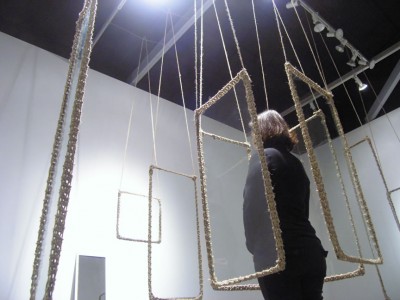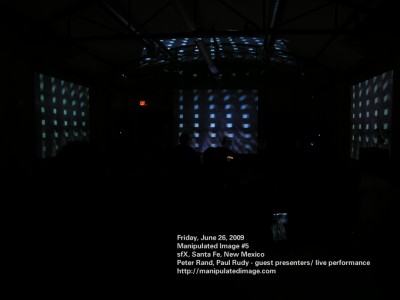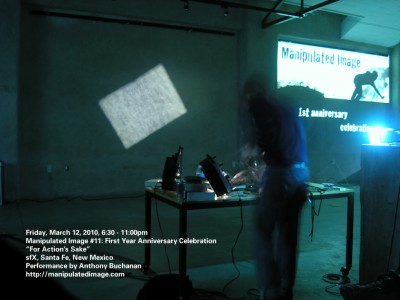ABOUT MANIPULATED IMAGE
Launched February 27, 2009
Alysse Stepanian: Creator, Curator, and Organizer (Transmedia and video artist)
Philip Mantione: Technical Director (Composer, multimedia artist)
Currently based in Los Angeles, Manipulated Image is an artist-driven project, featuring innovative video art and multimedia events by international artists, with guest artist discussions and presentations. Past screenings have presented diverse work within contexts that have allowed fresh discoveries about the possibilities of video art as a creative medium. MI has co-curated video art screenings with international partners. In its first 19 programs, it has presented work by 157 artists from 41 countries, and many of its curations have been presented internationally.
Manipulated Image has exposed local audiences to culturally diverse mix of ethnicities. It has increased worldwide opportunities for local artists by giving wider exposure to their work, and has provided venues for artists from around the globe to have their work shown in the US. Works of emerging artists are shown alongside the internationally known, spanning across age, sex, religion, ethnicity, nationality, and economic status.
INTERNATIONAL PARTNERSHIPS & MI’s FUTURE
Stepanian sees MI as a global endeavor, not restricted to one location or presentation format, and she looks forward to future local and international curatorial collaborations and online and offline exhibition venues. To date, MI’s curations have been presented in 25 venues in 13 countries. 2013-14 collaborations include “Nietzsche Was A Man”, videoart by 19 Iranian women, curated in collaboration with Neda Darzi of Persbook Art based in Iran. This curation has been exhibited at the Museo Ex Teresa Arte Actual in Mexico City, FONLAD in Portugal, Malmö Konsthall in Sweden, and is scheduled for other upcoming international exhibitions and screenings. In 2012 Manipulated Image launched MI_LosAngeles2012 (MI #15-17) with screenings and events at three locations in the L.A. area. 2012 international collaborations included an invitational curation for art:screen Fest 2012 at the Bio Roxy in Örebro, Sweden (MI #19), which travelled to the Vetlanda Museum in Sweden, the 700IS Reindeerland event at the Nordic House in Iceland, and Festival Miden in Greece. Other 2012 partnerships included traveling exhibitions for CologneOFF 2011 (MI#14) and a co-curation and online discussion at Sazmanab in Tehran, Iran (MI #18). In 2012 Stepanian also served as a juror for the 1st FESTIVAL of VIDEOARTIST.ir in Esfahan, Iran (see CURATORS & PARTNERS for more information).
CURATORIAL MISSION AND PHILOSOPHY
Artists rearrange bits and pieces of information and re-experience them anew, each time they engage in a creative act. The impact of a work of art results from the complex relationships between the present and the absent, the selected and discarded information. Viewers are engaged by perceiving relationships between objects, ideas, marks, sounds, images, and events. In 1970, Gene Youngblood wrote: “When we say expanded cinema we actually mean expanded consciousness. Expanded cinema does not mean computer films, video phosphors, atomic light, or spherical projections. Expanded cinema isn’t a movie at all: like life it’s a process of becoming, man’s ongoing historical drive to manifest his consciousness outside of his mind, in front of his eyes.” (Expanded Cinema, Pg. 41)
Digital media has changed our lives, ways of seeing and the speed with which we make choices and interact, in profound, yet mostly unconscious ways. Contemporary curators and artists have access to a large range of tools and need to deal with very dense layers of meaning. They are also encouraged or maybe even pressured to take on cross-disciplinary approaches. But it is important to be aware not only of new technological possibilities in the arts, but also of the pitfalls and the seduction of novelty. It seems that most work created at the advent of new technological inventions has difficulty in going beyond the immediate technical capabilities of the medium itself. Numerous online video channels and social networking sites make global dissemination of video easier than ever before. Online video libraries allow curators access to work they would otherwise have no knowledge of. At the most basic and visible level we have been presented with a whole new world of possibilities. With the jumble of voices out there, what remains important for an artist is the making of work that rises above a world cluttered with useless information.

Installation by Philip Mantione. Arena 1 Gallery. Santa Monica (see MI #17)
Manipulated Image provides venues for artists with unique voices, and with its varied programming compares and contrasts current movements in contemporary video art. Some of its curated programs strive to show a body of work by each artist, in order to better present the artist’s vision. Screenings of diverse work in each program expose audiences to the unfamiliar, encourage the reexamination of the familiar, and inspire fresh outlook toward the world. Letting go of one’s preconceived notions is fundamental in understanding the motivational drives of social forces, and the emergence of innovative and constructive dialogues.

THE BEGINNINGS OF MANIPULATED IMAGE
Video and transmedia artist, Alysse Stepanian lived in Santa Fe, New Mexico for three years. In February of 2009 she launched Manipulated Image in order to fill the void for a venue that offered regular presentations of contemporary video art. During its first year of inception, Manipulated Image pioneered in bringing work by a global community of experimental video artists to this U.S. city. Fresh and innovative work was culled from local, national and international artists, for unique programs that offered a sampling of current movements and conceptual frameworks in video art. Many of the videos screened were Santa Fe, US, or world premieres. Co-curatorial projects included two partnerships with VideoChannel Cologne based in Germany (MI #11 & MI #12), and a co-curation with Brazilian filmmaker Kika Nicolela (MI #13).
During its first 13 events, Manipulated Image hosted 22 guest video artists who discussed their work in person. It presented work by 121 video artists from 25 countries (5 continents), and live and online performances by 15 artists. Two of these programs presented live cinema performances and one took the audience on a tour of virtual art on Second Life. In a special MI program in April of 2009, pioneers of video art, Steina and Woody Vasulka, made a two- hour historic presentation from the Vasulka Archives. In May of 2010, “Absence||Presence” “Ausência || Presença” (MI #13) co-curated by Stepanian and Kika Nicolela of Brazil, brought work by 19 artists from Brazil and around the Globe to the Cinematheque at the Center For Contemporary Arts In Santa Fe.
The first year anniversary show of March 2010,”For Action’s Sake” (MI #11) was featured on the cover story of Pasatiempo, Santa Fe’s major arts and culture magazine. This 4.5-hour program presented videos and live and online performances by 23 artists from 10 countries, and a special one-hour curated compilation of videos by MI’s partner, VideoChannel Cologne. “For Action’s Sake” considered the confluence of art and politics. Direct and indirect references were made to the role of mass media in the present, and its relationship to Machiavellian and Fascistic politics. A play on words, the title was a reference to “art for art’s sake” and the failure of Modernism to fulfill its promise of bringing social change. For Action’s Sake contrasted autotelic individuals with those driven by external influences such as power and comfort, who in the end are left unfulfilled and alienated.

For more details see MI’s Archives.
Contact Alysse Stepanian: info[at]alyssestepanian.com








